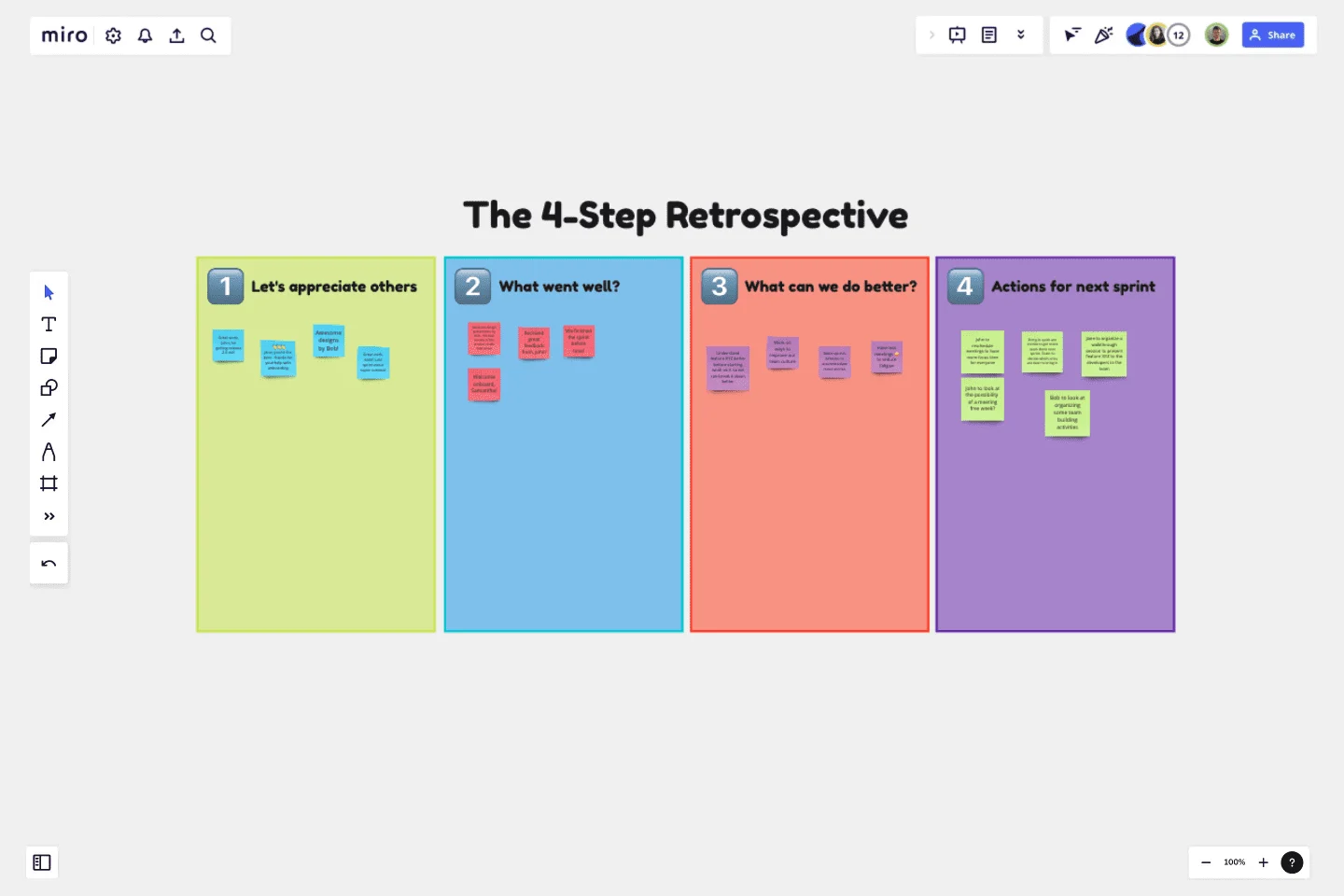The 4-Step Retrospective
The 4-step retrospective board is intended to quickly add a simple retrospective template for your retro sessions.
The 4-step retrospective board is intended to quickly add a simple retrospective template for your retro sessions. This covers the following four areas:
Let's appreciate others - Recognize your teammates for their fabulous work they've been putting in.
What went well? - Reflect and celebrate the various aspects that went well during the last sprint.
What can we do better? - Reflect on the things that didn't go so well and write down what would have been done better in that situation.
Actions for next sprint - Record actionable items that you and your teammates could do for the next sprint.
This template was created by Clyde D'Souza.
Get started with this template right now.
Product Inception Canvas
Works best for:
Product Management, Planning
The Product Inception Canvas template facilitates collaborative sessions for defining product visions and strategies. By exploring product goals, user needs, and market opportunities, this template aligns teams around a shared vision. With sections for defining product features, prioritizing initiatives, and setting success criteria, it provides a structured framework for product inception. This template serves as a launchpad for innovative product ideas, guiding teams through the initial stages of product development and setting the foundation for success.
Persona Empathy Map & Canvas
Works best for:
Product Management, Empathy Map
The Persona Empathy Map & Canva by Sophie RAOUL template helps you delve deep into your customers' minds. Create comprehensive personas and empathy maps to better understand your audience's thoughts, feelings, and behaviors. This tool is perfect for developing customer-centric products and marketing strategies. Ideal for UX designers, marketers, and product managers aiming to enhance user experience.
Agile Product Roadmap (Now, Next, Later)
Works best for:
Product Roadmap
Stay ahead in your product development with the Agile Product Roadmap Now Next Later template. This tool allows you to plan and prioritize features and improvements dynamically, ensuring your product evolves with market needs. Visualize short-term, mid-term, and long-term goals to keep your team focused and aligned. Perfect for product managers and agile teams aiming to deliver continuous value.
User Story Map Template
Works best for:
Marketing, Desk Research, Mapping
Popularized by Jeff Patton in 2005, the user story mapping technique is an agile way to manage product backlogs. Whether you’re working alone or with a product team, you can leverage user story mapping to plan product releases. User story maps help teams stay focused on the business value and release features that customers care about. The framework helps to get a shared understanding for the cross-functional team of what needs to be done to satisfy customers' needs.
Meeting Reflection Template
Works best for:
Meetings, Brainstorming, Team Meetings
When schedules get hectic, “learning by doing” becomes the default way to learn. So make time for your team to learn in other valuable ways — by reflecting and listening. Led by “learners,” (team members who share with the rest of the team), a meeting reflection lets teammates share new information about a client’s business or an internal business initiative, offer problem-solving techniques, or even recommend books or podcasts worth checking out. Meeting reflections also encourage colleagues at all levels to engage in each other’s professional development of their teammates.
BCG Matrix Template
Works best for:
Strategic Planning
Use the BCG matrix template to make informed and strategic decisions about growth opportunities for your business. Assign your portfolio of products to different areas within the matrix (cash cows, dogs, question marks, stars) to prioritize where you should invest your time and money to see the best results.
